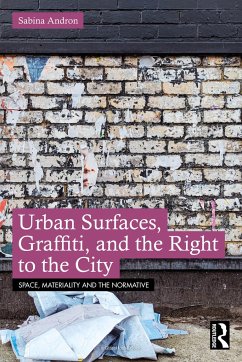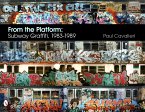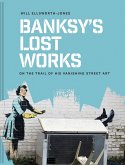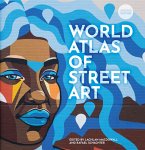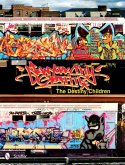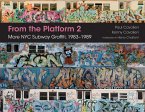Sabina Andron
Urban Surfaces, Graffiti, and the Right to the City
Sabina Andron
Urban Surfaces, Graffiti, and the Right to the City
- Broschiertes Buch
- Merkliste
- Auf die Merkliste
- Bewerten Bewerten
- Teilen
- Produkt teilen
- Produkterinnerung
- Produkterinnerung
This landmark book focuses entirely on urban surfaces, on exploring their authorship and management, and their role in struggles for the right to the city.
Andere Kunden interessierten sich auch für
![From the Platform: Subway Graffiti, 1983-1989 From the Platform: Subway Graffiti, 1983-1989]() Paul CavalieriFrom the Platform: Subway Graffiti, 1983-198931,99 €
Paul CavalieriFrom the Platform: Subway Graffiti, 1983-198931,99 €![Banksy's Lost Works Banksy's Lost Works]() Will Ellsworth-JonesBanksy's Lost Works17,99 €
Will Ellsworth-JonesBanksy's Lost Works17,99 €![The World Atlas of Street Art The World Atlas of Street Art]() Rafael SchacterThe World Atlas of Street Art23,99 €
Rafael SchacterThe World Atlas of Street Art23,99 €![New York City Graffiti New York City Graffiti]() George McAvoyNew York City Graffiti42,99 €
George McAvoyNew York City Graffiti42,99 €![From the Platform 2 From the Platform 2]() Paul CavalieriFrom the Platform 241,99 €
Paul CavalieriFrom the Platform 241,99 €![Richard Hambleton: Godfather of Street Art Richard Hambleton: Godfather of Street Art]() Vladimir Restoin RoitfeldRichard Hambleton: Godfather of Street Art53,99 €
Vladimir Restoin RoitfeldRichard Hambleton: Godfather of Street Art53,99 €![Under the Bridge Under the Bridge]() Paul CavalieriUnder the Bridge47,99 €
Paul CavalieriUnder the Bridge47,99 €-
-
-
This landmark book focuses entirely on urban surfaces, on exploring their authorship and management, and their role in struggles for the right to the city.
Hinweis: Dieser Artikel kann nur an eine deutsche Lieferadresse ausgeliefert werden.
Hinweis: Dieser Artikel kann nur an eine deutsche Lieferadresse ausgeliefert werden.
Produktdetails
- Produktdetails
- Space, Materiality and the Normative
- Verlag: Taylor & Francis Ltd
- Seitenzahl: 214
- Erscheinungstermin: 22. November 2023
- Englisch
- Abmessung: 234mm x 156mm x 12mm
- Gewicht: 370g
- ISBN-13: 9781032597515
- ISBN-10: 1032597518
- Artikelnr.: 68716146
- Herstellerkennzeichnung
- Libri GmbH
- Europaallee 1
- 36244 Bad Hersfeld
- gpsr@libri.de
- Space, Materiality and the Normative
- Verlag: Taylor & Francis Ltd
- Seitenzahl: 214
- Erscheinungstermin: 22. November 2023
- Englisch
- Abmessung: 234mm x 156mm x 12mm
- Gewicht: 370g
- ISBN-13: 9781032597515
- ISBN-10: 1032597518
- Artikelnr.: 68716146
- Herstellerkennzeichnung
- Libri GmbH
- Europaallee 1
- 36244 Bad Hersfeld
- gpsr@libri.de
Sabina Andron is Postdoctoral Fellow in Cities and Urbanism at the University of Melbourne, Australia.
Introduction: the city of surfaces 1
1 Surface semiotics: a manual for knowing surfaces 9
1. The places of discourse are fundamental to the production of meaning 10
2. Signification takes place in localised aggregates 14
3. Surfaces are thick and alive 20
4. Dirt is a crime 24
5. Order is white 29
6. Visibility generates value 33
7. Text makes space, and the city makes us literate 38
8. Surface betrayals and restitutions 42
9. Conclusion, or six proposals for the significance of signs and surfaces
45
10. Wall interview 48
2 Beyond art and crime: a critical history of graffiti and street art 58
1. Wall writing is a time portal 59
2. Graffiti is only a name 63
3. Every tag is collectively authored 65
4. The writing is not on the wall 69
5. Fear is a self-fulfilling prophecy 72
6. Gallery walls redeem urban walls 78
7. Street art is a different name 82
8. The image is not on the wall 85
9. Authoritarianism comes in beautiful colours 90
10. Urban creativity is a well-oiled machine 96
11. Street art sold my city 101
Conclusion, or six proposals against institutional appropriations 105
3 Law and graffiti: property, crime, and the surface commons 116
1. Law is everywhere; everywhere is law 117
2. Surfaces complicate property regimes 122
3. The right to the city is the right to the surface 126
4. Writing on walls has a long history of regulation 130
5. Graffiti offends against property and order 133
6. Offence is an ambiguous affair 138
7. The majority decides what is proper 141
8. The argument against art 147
Conclusion, or five proposals for a surface commons 149
4 Leake Street London: legal walls and deep surfaces 159
1. Ownership is tedious 161
2. Street art is just the beginning 163
3. Not all legal walls are created equal 166
4. Graffiti knows no boundaries 168
5. 100 Days of Leake Street is not enough 172
6. Tagging is pro-social 174
7. Eat drink shop graffiti 180
Conclusion, or five proposals for learning from Leake Street 186
Conclusion: cultural heritage and the right to the surface city 190
The right to the city is the right to the surface: a manifesto 197
Acknowledgements 199
Index 201
1 Surface semiotics: a manual for knowing surfaces 9
1. The places of discourse are fundamental to the production of meaning 10
2. Signification takes place in localised aggregates 14
3. Surfaces are thick and alive 20
4. Dirt is a crime 24
5. Order is white 29
6. Visibility generates value 33
7. Text makes space, and the city makes us literate 38
8. Surface betrayals and restitutions 42
9. Conclusion, or six proposals for the significance of signs and surfaces
45
10. Wall interview 48
2 Beyond art and crime: a critical history of graffiti and street art 58
1. Wall writing is a time portal 59
2. Graffiti is only a name 63
3. Every tag is collectively authored 65
4. The writing is not on the wall 69
5. Fear is a self-fulfilling prophecy 72
6. Gallery walls redeem urban walls 78
7. Street art is a different name 82
8. The image is not on the wall 85
9. Authoritarianism comes in beautiful colours 90
10. Urban creativity is a well-oiled machine 96
11. Street art sold my city 101
Conclusion, or six proposals against institutional appropriations 105
3 Law and graffiti: property, crime, and the surface commons 116
1. Law is everywhere; everywhere is law 117
2. Surfaces complicate property regimes 122
3. The right to the city is the right to the surface 126
4. Writing on walls has a long history of regulation 130
5. Graffiti offends against property and order 133
6. Offence is an ambiguous affair 138
7. The majority decides what is proper 141
8. The argument against art 147
Conclusion, or five proposals for a surface commons 149
4 Leake Street London: legal walls and deep surfaces 159
1. Ownership is tedious 161
2. Street art is just the beginning 163
3. Not all legal walls are created equal 166
4. Graffiti knows no boundaries 168
5. 100 Days of Leake Street is not enough 172
6. Tagging is pro-social 174
7. Eat drink shop graffiti 180
Conclusion, or five proposals for learning from Leake Street 186
Conclusion: cultural heritage and the right to the surface city 190
The right to the city is the right to the surface: a manifesto 197
Acknowledgements 199
Index 201
Introduction: the city of surfaces 1
1 Surface semiotics: a manual for knowing surfaces 9
1. The places of discourse are fundamental to the production of meaning 10
2. Signification takes place in localised aggregates 14
3. Surfaces are thick and alive 20
4. Dirt is a crime 24
5. Order is white 29
6. Visibility generates value 33
7. Text makes space, and the city makes us literate 38
8. Surface betrayals and restitutions 42
9. Conclusion, or six proposals for the significance of signs and surfaces
45
10. Wall interview 48
2 Beyond art and crime: a critical history of graffiti and street art 58
1. Wall writing is a time portal 59
2. Graffiti is only a name 63
3. Every tag is collectively authored 65
4. The writing is not on the wall 69
5. Fear is a self-fulfilling prophecy 72
6. Gallery walls redeem urban walls 78
7. Street art is a different name 82
8. The image is not on the wall 85
9. Authoritarianism comes in beautiful colours 90
10. Urban creativity is a well-oiled machine 96
11. Street art sold my city 101
Conclusion, or six proposals against institutional appropriations 105
3 Law and graffiti: property, crime, and the surface commons 116
1. Law is everywhere; everywhere is law 117
2. Surfaces complicate property regimes 122
3. The right to the city is the right to the surface 126
4. Writing on walls has a long history of regulation 130
5. Graffiti offends against property and order 133
6. Offence is an ambiguous affair 138
7. The majority decides what is proper 141
8. The argument against art 147
Conclusion, or five proposals for a surface commons 149
4 Leake Street London: legal walls and deep surfaces 159
1. Ownership is tedious 161
2. Street art is just the beginning 163
3. Not all legal walls are created equal 166
4. Graffiti knows no boundaries 168
5. 100 Days of Leake Street is not enough 172
6. Tagging is pro-social 174
7. Eat drink shop graffiti 180
Conclusion, or five proposals for learning from Leake Street 186
Conclusion: cultural heritage and the right to the surface city 190
The right to the city is the right to the surface: a manifesto 197
Acknowledgements 199
Index 201
1 Surface semiotics: a manual for knowing surfaces 9
1. The places of discourse are fundamental to the production of meaning 10
2. Signification takes place in localised aggregates 14
3. Surfaces are thick and alive 20
4. Dirt is a crime 24
5. Order is white 29
6. Visibility generates value 33
7. Text makes space, and the city makes us literate 38
8. Surface betrayals and restitutions 42
9. Conclusion, or six proposals for the significance of signs and surfaces
45
10. Wall interview 48
2 Beyond art and crime: a critical history of graffiti and street art 58
1. Wall writing is a time portal 59
2. Graffiti is only a name 63
3. Every tag is collectively authored 65
4. The writing is not on the wall 69
5. Fear is a self-fulfilling prophecy 72
6. Gallery walls redeem urban walls 78
7. Street art is a different name 82
8. The image is not on the wall 85
9. Authoritarianism comes in beautiful colours 90
10. Urban creativity is a well-oiled machine 96
11. Street art sold my city 101
Conclusion, or six proposals against institutional appropriations 105
3 Law and graffiti: property, crime, and the surface commons 116
1. Law is everywhere; everywhere is law 117
2. Surfaces complicate property regimes 122
3. The right to the city is the right to the surface 126
4. Writing on walls has a long history of regulation 130
5. Graffiti offends against property and order 133
6. Offence is an ambiguous affair 138
7. The majority decides what is proper 141
8. The argument against art 147
Conclusion, or five proposals for a surface commons 149
4 Leake Street London: legal walls and deep surfaces 159
1. Ownership is tedious 161
2. Street art is just the beginning 163
3. Not all legal walls are created equal 166
4. Graffiti knows no boundaries 168
5. 100 Days of Leake Street is not enough 172
6. Tagging is pro-social 174
7. Eat drink shop graffiti 180
Conclusion, or five proposals for learning from Leake Street 186
Conclusion: cultural heritage and the right to the surface city 190
The right to the city is the right to the surface: a manifesto 197
Acknowledgements 199
Index 201

